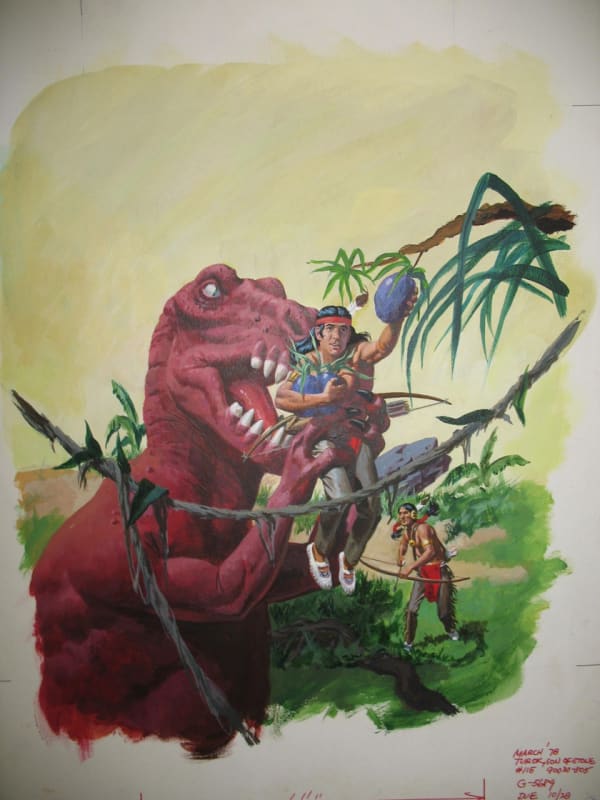George Wilson: The Golden Age of Comic Books: Star Trek, Turok, The Lone Ranger, Flash Gordon
-
 George Wilson, Dagar The Invincible ,"Vengence, Sweet Vengence", Issue #4, February 1973
George Wilson, Dagar The Invincible ,"Vengence, Sweet Vengence", Issue #4, February 1973 -
 George Wilson, Star Trek, "World Against Time", Issue #42, January 1977
George Wilson, Star Trek, "World Against Time", Issue #42, January 1977 -
 George Wilson, The Lone Ranger, "Pay or Burn", Issue #27, December 1976
George Wilson, The Lone Ranger, "Pay or Burn", Issue #27, December 1976 -
 George WIlson, Space Family Robinson Lost in Space, "Accident in Hyperspace", Issue #40, July 1974
George WIlson, Space Family Robinson Lost in Space, "Accident in Hyperspace", Issue #40, July 1974
-
 George Wilson, Star Trek, "Dwaf Planet", Issue #25, July 1974
George Wilson, Star Trek, "Dwaf Planet", Issue #25, July 1974 -
 George Wilson, Turok: Son of Stone, "Andar's Helpful Honker", Issue #115, May 1978
George Wilson, Turok: Son of Stone, "Andar's Helpful Honker", Issue #115, May 1978 -
 George Wilson, UFO & Outerspace, "What If-?", Issue #20, February 1979
George Wilson, UFO & Outerspace, "What If-?", Issue #20, February 1979 -
 George Wilson, UFO Flying Saucers, "Exciting Reports of Recent Encounters", Issue #4, November 1974
George Wilson, UFO Flying Saucers, "Exciting Reports of Recent Encounters", Issue #4, November 1974
The early 1960s is known in the world of comics as "The Silver Age". It was within this period of time that the superhero genre in comics experienced a revival, and a significant jump in sales was seen for almost all of the industry's publishing houses. "The Bronze Age" is the comic book era from 1970-1984, a time when baby boomers were in their youth and the United States was simultaneously experiencing bell-bottoms and the after-affects of the cold war. Comic books provided an escape through adventures of superheroes and science fiction. Star Trek was then a new and popular television series that created characters with strengths and faults with which its American audience strongly related to.
This exhibition encompassed a collection of forty original comic book cover paintings, which were created for the covers of Star Trek, Turok: Son of Stone, The Lone Ranger, Flash Gordon, Ripley's Believe It or Not, and other Gold Key characters. These paintings are considered collectible, in that, for each issue there was only one cover for each comic. Many publishers did not store the original artwork for the comics since they had little use for it once the art was published. The publishers who did choose to store these works would find themselves with a warehouse full of images that they deemed both useless and invaluable, and in order to utilize their space, they would burn them or simply throw them away. Today, these original works are extraordinary paintings by artists skilled at graphic expression and have become a rare commodity.
ABOUT GOLD KEY COMICS
In 1962, Western Publishing Company, a powerhouse of the publishing world, severed their long-standing relationship with Dell Comics and formed their own Gold Key Comics. Operating out of offices located in upstate Poughkeepsie, N.Y., Gold Key's approach to production was distinctly different from that of other major publishers. They were among the very first to introduce glossy cover layouts that featured attractive full-color paintings every issue instead of the customary line drawings seen everywhere else. Gold Key was essential in redefining the credentials for quality within the comic book genre, and with that progression spawned a whole new generation of comics based on fantasy and science fiction. Among these were the popular titles, Space Family Robinson Star Trek, UFO & Outerspace, and Fantastic Voyage. Gold Key also provided their readers with spine-tingling tales of horror and mystery with Grimm's Ghost Stories, Boris Karloff's Tales of Mystery and Mystery Science Digest. The cover artists of Gold Key were well-achieved individuals who utilized vibrant colors in gouache to immortalize the characters within the comics' pages. Their keen attention to detail is immediately apparent in each of these paintings. For example, the highlights on the scales of a Turok dinosaur, or those on the muscles of Tarzan are merely two small examples of the rich quality inherent in each cover piece. Expressions of horror, delight, curiosity, and conviction are all executed beautifully and tactfully, and with a clarity reminiscent of the realist painters of the 18th and 19th centuries. These pieces stand as testimony of a truly modern American-born art form, the art of the comic.








